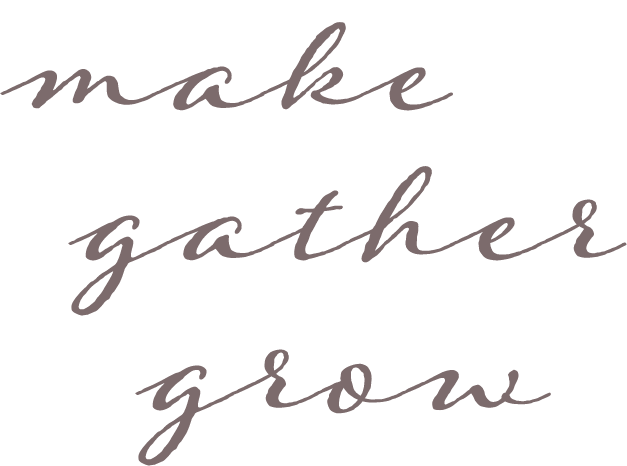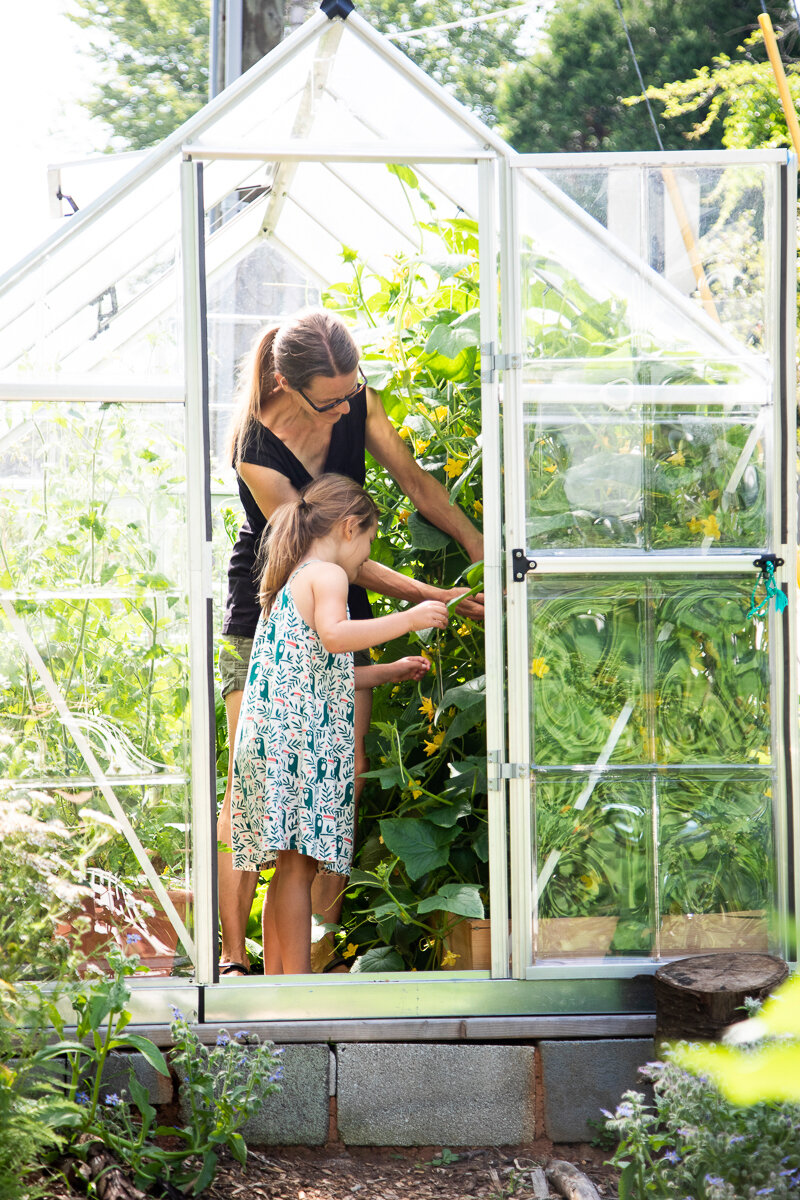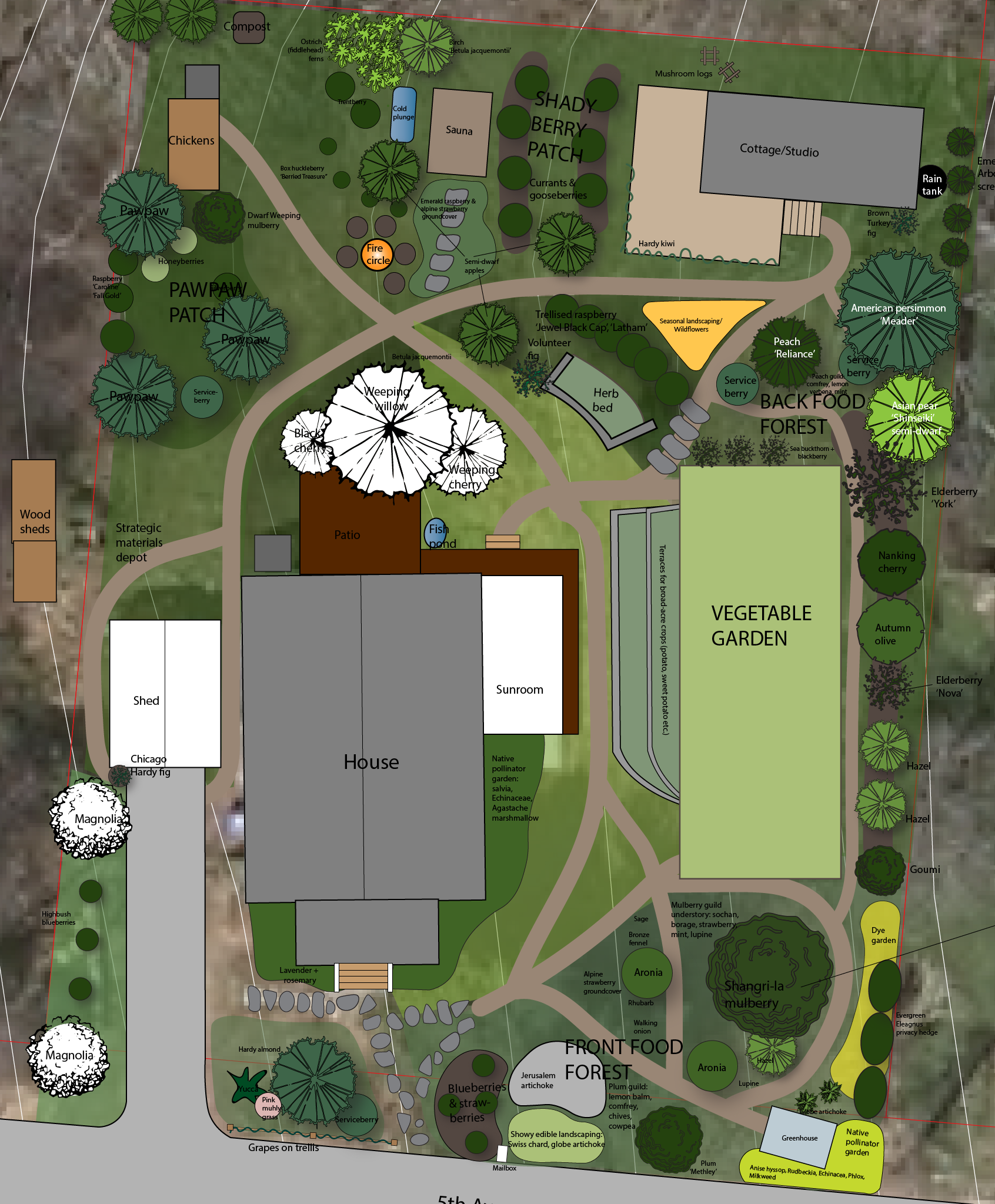Our homestead story & design
Just after New Year’s in 2018, we returned to the Carolinas after almost two years away. We'd spent six months in California for my ecological landscaper training, over a year in India for Dan’s research, and some family time in between in Finland and Boston. We’d always been quite nomadic, but that amount of shifting was a bit much even for us. At that point, I wanted nothing more than to put down roots, to be in one place, to find our home & homestead.
Within one month of our return to the States, we got our offer accepted on a blue cottage, on a double lot, in Asheville.
As I often tell friends, it was love at first sight. The cottage was small, but we're used to living in small spaces. It was a well-loved house, one that felt like a home. We loved the wood stove, the French doors that opened out into the sunroom, and the little details like the kitchen countertops with fossils embedded in them.
Humble beginnings
The yard wasn’t much to write home about. It was a mossy, weedy lawn, with a couple of diseased cherry trees and a tangle of invasive vines and privet to the north and east, where the lot borders a large wooded area with a small creek running at the bottom. There was an abandoned chicken coop surrounded by a chain-link fence. The soil was compacted and clayey.
But I saw the potential right away. Almost one third of an acre of mostly open land! I saw before my eyes a future edible landscape overflowing with fruits, nuts, berries, vegetables, herbs, medicinals, dye plants, flowers, mushrooms. A space that would feed us and and our friends and community.
I drew my first, quick and dirty, back-of-the-napkin design for the garden the night when our offer was accepted. Being the diligent permaculture designer that I am, I knew that we would first wait and observe the land for a while before making any big design decisions. That first sketch was just getting all my wild dreams out on paper. Funnily enough, when I look back on it, a lot of those early design-on-the-fly ideas were goods ones that we ended up implementing.
We are homesteading on Cherokee land.
First year on the land: Building soil
The only things we planted in the first year were the vegetable garden and the blueberry patch, as it was easy to figure out the best site for those two right away. We put the garden on the eastern slope that gets full sun, and planted the blueberries in the acidic soil after an arborist cut down the one pine tree that shaded the yard.
But our main goal for the first year was just to build soil. I knew from my years of permaculture & regenerative farming learning that healthy soil is the starting point for a healthy farm or garden ecosystem. Porous, crumbly, dark soil rich in humus (soil organic matter) and teeming with soil microbes, worms and other critters. Even though it meant delaying the planting of my dream food forest, it was worth it to invest the time and improve the soil.
We double-dug the garden in the fenced-in area, and brought in tons of compost and soil amendments based on the soil test. We've been practicing no-till gardening ever since and are really happy with the results.
Outside of the fenced-in garden area, while started building the soil by
growing a cover crop over the sheet mulch
the following year, we did one more layer of sheet mulch
and, in general, adding to the land wheelbarrow after wheelbarrow of compost, mulch, and woodchips we get for free from the arborist
We welcomed our first chicks that first spring.
As they grew fast, we had to quickly build a chicken run. We re-painted the old chicken coop and built the run out of reclaimed wood.
This was the garden our first summer here.
Design concept
In spring 2019, one year in, I finalized the homestead landscape design and we finally planted our first fruit trees and other perennials.
I used Edible Forest Gardens by Dave Jacke and Eric Toensmeier to go through the most diligent design process I've ever done. After months of site research and playing with layers of tracing paper, I formulated a design concept:
Concentric circles of earthworks and plantings surround and protect — like the rings of a tree — the heartwood that is the home and its outdoor social and private zones. These earthworks and plantings capture water, sunlight, and carbon, and turn them into an urban edible abundance of fresh berries, fruit, vegetables, and herbs where we can go foraging year-round. The outermost rings of perennials enclose a rich mosaic of annuals and perennials, creating a lush, secluded sanctuary nestled by the creekside woodland.
Some of the other things we did to create structure and meet the design goals:
A swale along the eastern side of the property (top of property), planted with perennial edibles: elderberry, hazelnut, autumn olive, goumi, and Nanking cherry. These perennials double as an edible privacy hedge.
Terraced beds on the steepest slopes to capture water, stop erosion, and make use of those spaces as growing space
Gravel pathways to the cottage and wood chip pathways and flagstones everywhere else
Raspberry trellises
We added the greenhouse in Fall 2019 and the sauna in Fall 2020
That first year also saw the completion of the backyard guesthouse/studio. We didn’t build it ourselves — we hired awesome local tiny house builders to do it — but we were very involved in the design and the building process.
Photo: Erin Adams
Full homestead design
Now presenting: our up-to-date edible landscape design! Most of these fruit trees and shrubs are already in the landscape. We're adding a few more this year: grapes, more gooseberries and currants, trentberries, huckleberries and silverberries... and maybe a few more things... If you're a plant addict like me, you understand.
This is Hidden Creek Homestead (there IS a hidden creek, but that's another story...) ...an ongoing labor of love. I'd love to hear any questions or responses in the comments if you have them!














